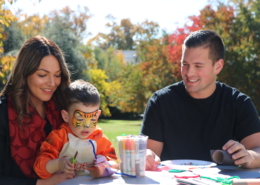Last summer, we wrote about our discovery of a note in the attic that contained a lock of hair. (on facebook: Found in the Attic Part III and Secrets Revealed! Found in the Attic Part IIIa) The note eventually helped staff discover the true owner of a locket inscribed “our child” in our hairwork jewelry collection. Well, this inspired us to look closer at the hairwork jewelry collection (which includes pieces with George and Martha Washington’s hair) and develop a mini-exhibition and evening lecture….
Jewelry Made with Human Hair?
Tudor Place Presents: Strands of Time
Lecture and Exhibit of 18th and 19th century
Hairwork Jewelry
WASHINGTON, DC – In the Tudor Place collection is an unassuming gold edged locket. Behind glass on each side of the locket are curled locks of
George and Martha Washington’s hair (DNA tested and confirmed by the FBI). This locket is one of a number of pieces of hairwork jewelry that is currently
on display at Tudor Place through April 30, 2010. The exhibit is free with regular admission. A special lecture “
Strands of Time: Lecture on Tudor Place’s Hair Jewelry” will be held on
March 30, at 6:45pm. The cost is $8 per person and is free for Tudor Place members. (register for the lecture here:
https://strandsoftime.eventbrite.com/)

“During the 19th century hairwork jewelry exploded in popularity fueled by Britain’s Queen Victoria, who wore hairwork jewelry while mourning the death of her late husband in 1861. Fashion in both Britain and America began to reflect a growing trend for this type of jewelry of sentiment.” notes Collections Manager Fay Winkle. “The heavy losses of life during the Civil War increased the market for hairwork jewelry in the late 19th century, as wives, mothers and friends wanted mementos of their lost loved ones.”

“Though jewelry made with hair sounds rather macabre, this collection and the complex techniques used to make these pieces is actually quite beautiful,” says Winkle. The intimacy of a lock of hair as a means of preserving the memory of a person is still as powerful today as it was in the 19th century and earlier. In our current era of photographs, videos, and webcams it is interesting to note that clipping and retaining a lock of a baby’s hair is still a common practice, though now placed in a baby book or scrapbook.
The idea for this exhibit came from a discovery last summer of a note containing a lock of child’s hair from 1845. The note helped the Tudor Place staff trace the provenance of a locket in the collection containing hair and inscribed “our child.”






